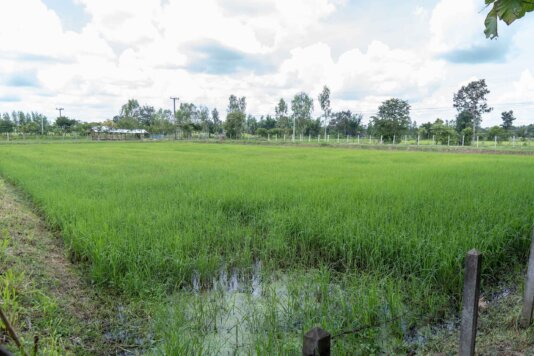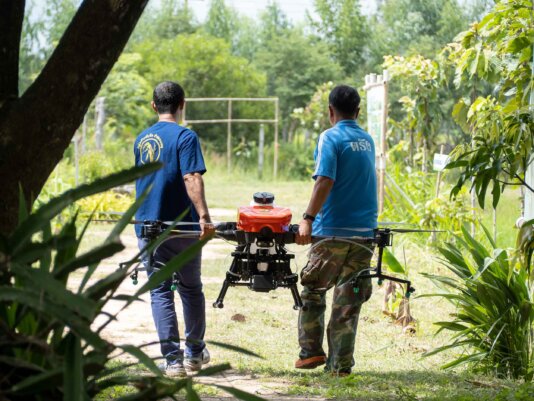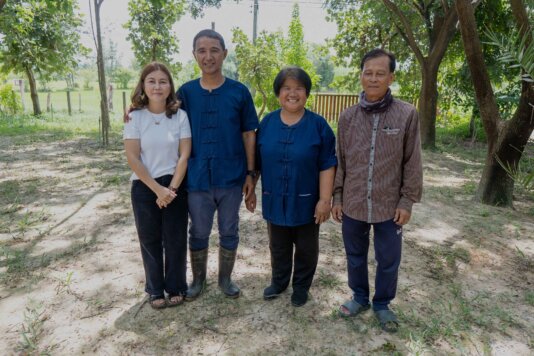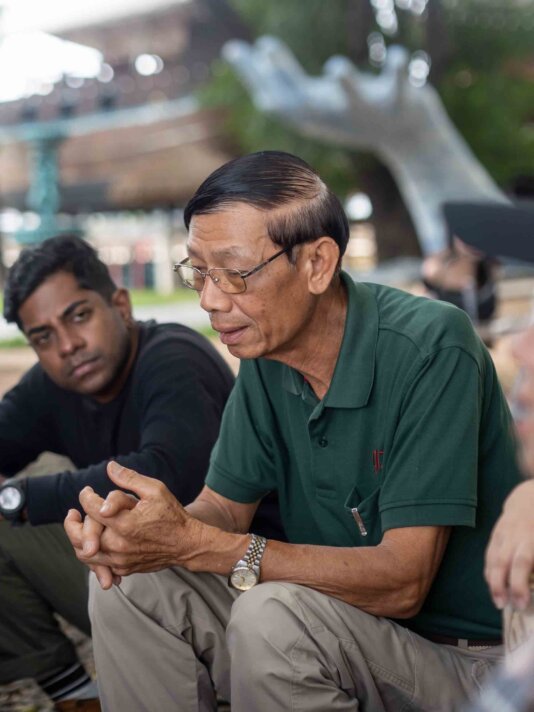- About
- Topics
- Picks
- Audio
- Story
- In-Depth
- Opinion
- News
- Donate
- Signup for our newsletterOur Editors' Best Picks.Send
Read, Debate: Engage.
| October 09, 2024 | |
|---|---|
| topic: | Sustainable Agriculture |
| tags: | #rice, #Sustainable Agriculture |
| located: | Thailand |
| by: | Toh Ee Ming |
Every day, rice sustains billions across Asia and the globe, serving as an essential, affordable source of nutrition for many of the world's most vulnerable populations.
But rice is a water-intensive crop, consuming 40 per cent of the world’s irrigation supply, with 3,000 to 5,000 litres required to produce just one kilogramme.
Now, its future is in jeopardy due to the climate crisis. Rising temperatures, unpredictable weather patterns and extreme events are causing yields to decrease.
Traditional cultivation methods, such as flooding paddy fields and burning rice stubble, contribute roughly 10 per cent of global man-made methane emissions, and also involve heavy use of fertilisers and pesticides.
As demand for rice increases, climate change threatens to reduce yields by 15 per cent by 2050, putting food security and the livelihoods of smallholder farmers at risk. In response, governments, international organisations and corporations are collaborating with farmers to make rice production more inclusive and sustainable.
In Thailand, one of the world’s top rice producers, the humble grain is central to both its culture and economy.
The country has set a target to reduce its greenhouse gas emissions by 25 per cent by 2030, supported by advancements in technology, finance and capacity building. As the fourth-largest CO2 emitter from rice cultivation, which accounts for 57.7 per cent of its agricultural emissions, Thailand faces the challenge of making rice production more sustainable. While not explicitly referenced in its updated Nationally Determined Contributions (NDC), the government has committed to reducing rice-related emissions by 26 per cent.
In August, FairPlanet visited Ubon Ratchathani, one of the nation’s leading rice producing provinces in the northeastern Isan region on the border with Laos and Cambodia.
Ubon, a rural province known for its rice paddies and small villages, is celebrated for producing Thai hom mali, a premium variety of jasmine rice prized for its aromatic fragrance and light, delicate texture.
In water-scarce regions like Ubon, farmers are cutting methane emissions by intentionally allowing their fields to dry out.
Standing water in rice fields fosters methane-producing bacteria, so a technique involving intermittent drying and reflooding has been tested. This alternate wetting and drying method shortens the irrigation period, reduces water usage and lowers methane emissions.
Farmers Thanu Thanhakij and Bunjong Pan-in recounted how climate change has recently upended the rhythm of the seasons that rice depends upon.
Farmers, Thanu said, can no longer rely on the monsoon season to start in April; sometimes, the rains don’t arrive until August. During droughts, there may be too little moisture for seedlings to grow or to apply fertiliser. Conversely, excessive water can drown the plants.
Rising temperatures also threaten rice production, as heat stress impairs flower pollination and causes fungus attacks. The resulting lower yields or failed crops deeply impacted farming families. Thanu said his rice crop output has sometimes dropped by 50 per cent.
Now, more than ever, rice producers must reconsider how they farm one of the world’s most important crops.
To adapt to climate challenges, Thanu has implemented innovative rice cultivation techniques on his 4.5-hectare farm, which also serves as a learning centre for local and international stakeholders.
Leading a cooperative of 89 farmers, the 56-year-old uses organic manure from cows and chickens and liquid fertilisers from food waste and enzymes. Thanu also employs automation, including tractors and other machinery, which he leases to neighbours for a small fee.
Previously, farmers would do dry broadcasting (scattering or spreading seeds over a wide area without planting them individually). Thanu now uses a direct seeding machine, reducing seed usage from 20 to 30 kg per rai to just 3.5 kg.
Direct seeding with machines rather than manual transplanting and broadcasting is more effective because it is faster, reduces labour and costs, avoids seedling shock, and ensures uniform seed distribution. The process also requires less water: with transplanting, fields need to be flooded to support the seedlings, while direct seeding can be done in drier conditions. That means a lower environmental footprint and greater overall efficiency.
After three days of training, Thanu mastered using a large drone to disperse liquid and solid fertilisers across his rice fields. This has reduced manual application time from 20 minutes to just three minutes, improves precision and prevents trampling.
To further boost his income, Thanu has diversified into agroforestry, growing lime, mangoes, and guava on other plots of land, selling 14 types of fish, and rearing cattle. Despite high salinity soil challenges that limit crop rotation, Thanu’s methods ensure a stable income.
Thanu has doubled his yield to 3 metric tons per hectare, lowering costs and achieving a net profit of 140,000 baht (USD 4,080) annually, significantly higher than the local average, attracting interest from other farmers.
These changes are credited partly to efforts by Thai government agencies and public, private and non-governmental partners, such as agri-business Olam Agri.
“Smallholder rice farmers lack the means to invest in high-quality seeds and machinery and have limited access to knowledge, advice, networks and market,”Narawadee Modenuch, research and sustainability manager at Olam Agri (Thailand), told FairPlanet.
From 2018 to 2022, Olam Agri has worked with Deutsche Gesellschaft für Internationale Zusammenarbeit (GIZ) and the Thai Rice Department to implement the Sustainable Rice Platform (SRP) standard with rice smallholder farmer groups. In the pilot province of Ubon Ratchathani, this initiative has increased farmers’ income by 20 per cent and reduced greenhouse gas emissions of farming in Thailand by 21 per cent, Agri said.
Another trend is that a growing number of environmentally-conscious consumers are interested in high-quality, traceable, certifiable and sustainably grown rice, Olam Agri’s team noted.
From 2018 to 2022, EUR 11 million was invested to create a sustainable rice supply chain, connecting Thai and Vietnamese farmers with the European and US markets.
The project certified 8,600 producers to SRP standards and trained 35,000 farmers in eco-friendly practices, such as reducing fertiliser misuse (or using recommended fertiliser formulas), stopping stubble burning, and producing organic compost for farmers’ use and sale, using transparent, easy-to-understand materials and digital tools.
Farmers track their crop production using diaries, which provide data to help guide better decision-making. Local leaders promote adopting new practices within the community and ensure accountability among members.
The farmers even receive support from a ‘rice doctor,’ Montree Promaluksana, GIZ’s field manager. With over two decades at the Rice Department of Thailand, Montree travels from village to village, dispensing tips and troubleshooting farmers’ problems via WhatsApp messages and phone calls.
As a result, rice-related greenhouse emissions in pilot provinces dropped by 21 per cent.
On the back of these successes, €4 million in funding was provided to Olam-GIZ’s project by the United Nations Environment Programme (UNEP) to assist even more farmers and cut emissions.
“Ten years ago, discussing climate change did not resonate much with farmers. However, as they increasingly experience its impacts firsthand, interest and action has grown,” said Narawadee. “Farmers are now more aware of climate change’s unpredictability and are actively seeking to learn more. They pay close attention to training.”
A five-year Thai Rice Green Climate Fund (GCF) project is underway, marking the first GCF project to focus solely on transforming rice production systems with a focus on circular economy solutions. As the world’s largest climate fund, the GCF supports developing countries combating climate change.
According to Pavich Kasawong, deputy director-general of the Thai government’s Department of Climate Change and Environment, the project aims to drive large-scale adoption of sustainable, climate-smart farming practices, benefiting over 250,000 smallholder farmers in Thailand and reducing agricultural emissions by 2.4 million tonnes of CO2 equivalent.
The Thai government and scientists are also developing climate-resilient rice varieties through breeding programmes.
In the broader region, the International Rice Research Institute in the Philippines and its partners have recently developed heat-tolerant rice varieties in Bangladesh. Trials have shown these new lines can yield 1.5 to 2 tonnes more per hectare than traditional varieties.
Moving forward, consumers should focus not just on organic rice but on the need for more sustainably produced rice, said Narawadee.
Narawadee emphasised that selling rice now involves highlighting its environmental and social impacts, especially with new EU sustainability regulations. While organic rice has a niche market and higher costs, sustainably produced rice - using inorganic fertilisers - strikes a balance between high yields, environmental protection and economic viability for farmers.
Narawadee said, “The hope is that sustainably grown rice will be the new convention. The narrative needs to shift to how we feed the world population, minimise the impact on the environment and do good.”
Professor Paul Teng, associate senior fellow in the Climate Change in Southeast Asia Programme at ISEAS – Yusof Ishak Institute, told FairPlanet that targeted interventions are essential for sustainable rice farming practices.
Farmers in drought-prone areas like Northeast Thailand are cautious about using alternate wetting and drying without expert guidance on water and fertiliser management. Overuse of fertilisers is common, and switching to organic options is challenging due to limited access to quality manure. While mechanisation and direct seeding are beneficial, they can lead to weed issues and require expensive equipment. Financial constraints make farmers more open to new methods but need credit support for these transitions.
“Rice farming is particularly challenging to decarbonise, and farmers - often among the poorest of the poor - need convincing that new strategies will lead to increased yields and profits, which currently go to middlemen and traders,” said Prof Teng.
As the world gets warmer and farmers continue to feel firsthand the effects of climate change, a road of uncertainty lies ahead.
For Thanu, climate change will bring a new level of unpredictability, and he will constantly have to keep up. “Climate change is becoming more severe and difficult to predict; we need to keep changing our approach,” he said.
Images supplied by Olam-Agri.
By copying the embed code below, you agree to adhere to our republishing guidelines.



